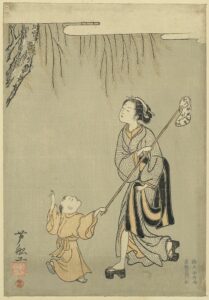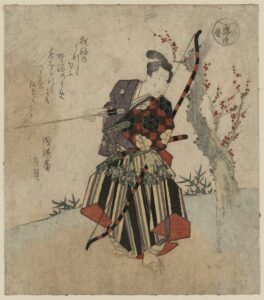Sosaku-hanga is a form of Japanese printmaking that empowers the artist with complete creative control.
Unlike traditional methods, where the creation process was divided among different specialists, this movement champions the artist as the sole creator.
We’ll explore the roots of sosaku-hanga and its impact on the art world.
Discover how this revolutionary approach reshaped perceptions of Japanese printmaking and influenced artists across the globe.
Origins Of Sosaku-hanga
The birth of sosaku-hanga can be traced back to the late 19th and early 20th centuries.
Discontented with the rigid ukiyo-e tradition, which segmented the process into designer, carver, and printer roles, a new breed of japanese artists sought a more personal and expressive form of printmaking.
They were inspired by Western artistic movements such as Impressionism and the idea of the artist as a solitary genius, fully in control of their work from conception to completion.
As we jump into the historical context surrounding the inception of sosaku-hanga, key figures emerge.
Tomimoto Kenkichi and Ishii Hakutei are often recognized as pioneers, promoting the concept of ‘jiga, jikoku, jizuri’ – self-drawn, self-carved, self-printed.
This philosophy was a direct challenge to the collaborative nature of traditional Japanese art-making, and it slowly began to gather a following among artists who yearned for a deeper connection to their craft.
The movement gained momentum with the establishment of groups like the Japan Creative Print Association or Nihon Sosaku-Hanga Kyokai.
Founded by Kanae Yamamoto, the association provided a platform for these artists to showcase their autonomous creations.
Besides, national exhibitions like the Teiten fostered recognition and growth.
We must consider key works such as Romance by Kanae Yamamoto and Self-Portrait by Minami Kunzo, which not only pushed the boundaries of printmaking but also encapsulated the spirit of creative independence that sosaku-hanga exemplified.
Diving into the philosophy behind this art form, we see that the principles of sosaku-hanga embedded a revolutionary ethos in those who practiced it:
- The artist must convey genuine self-expression,
- Artwork creation becomes a solitary pursuit for artistic truth,
- Every stage of production, from design to print, holds equal importance.
These precepts didn’t just influence the methodologies of printmaking; they altered the cultural narrative surrounding Japanese art on a global scale.
Through sosaku-hanga, Japanese artists communicated their individual perspectives, contributing to a diverse and dynamic cultural conversation.
Traditional Japanese Printmaking
Before delving into the core principles of sosaku-hanga, it’s essential to understand the historical context from which it emerged.
Traditional Japanese printmaking, known as ukiyo-e, celebrated the collaboration between the artist, carver, printer, and publisher.
This division of labor allowed ukiyo-e to thrive during the Edo period and beyond.
The artists sketched the designs, carvers etched them onto woodblocks, printers inked and pressed the blocks onto paper, and publishers distributed the final products.
Ukiyo-e prints portrayed a variety of subjects, from sumptuous landscapes and scenes of daily life to portraits of Kabuki actors and courtesans.
Works such as Hokusai’s The Great Wave off Kanagawa and Hiroshige’s The Fifty-three Stations of the Tokaido stand as evidence to this form’s deep connection with Japanese culture and aesthetics.
Through this practice, Japanese printmaking gained enormous popularity, influencing artists and movements worldwide, including the Impressionists in Europe.
The major shift sosaku-hanga brought was the artist’s role as the sole creator.
Looking at ukiyo-e’s collaborative approach, the sosaku-hanga movement sought to imbue prints with the artist’s creative spirit and individualistic expression.
Here, artists would conceive the design, carve the woodblocks, and print the images themselves.
As a result, sosaku-hanga prints often have a markedly different aesthetic and narrative presence, reflecting the autonomous journey from conception to completion.
Key aspects of sosaku-hanga that diverge from traditional methods include:
- Total artist control over all production stages,
- Experimentation with materials and techniques,
- A focus on the artist’s subjective vision and personal themes.
Sosaku-hanga’s distinction from classic ukiyo-e established it as more than just a technical innovation.
It represented a philosophical realignment that resonated with global movements valuing artistic authenticity and personal touch.
As we explore the lives of sosaku-hanga artists and their work, we find stories of resistance, innovation, and a relentless quest for self-expression through the medium of print.
The Rise Of Sosaku-hanga
The advent of sosaku-hanga marked a tangible shift in artists’ approaches to printmaking.
As we jump into the rise of this captivating art movement, we’re struck by the extent of its influence on individual expression and technique in the early 20th century.
Sosaku-hanga artists sought to democratize art, embodying the principle of jiga, jikoku, jizuri – self-drawn, self-carved, self-printed – which stood as a silent protest against the industrialized production methods of the time.
These artists, like Kanae Yamamoto and Un’ichi Hiratsuka, were pioneers who championed the freedom of the artist’s hand.
Their belief in personal creation propelled sosaku-hanga into the cultural limelight.
Innovative works such as Fishermen by Yamamoto and The Checkered Tablecloth by Hiratsuka are perfect exemplars of the movement’s dedication to artistry over mechanical reproduction.

As a filmmaking site, we admire how sosaku-hanga parallels the auteur theory in cinema, emphasizing the importance of the filmmaker’s personal influence as a crucial component of artistic integrity.
Sosaku-hanga’s growth coincided with a period of significant social and cultural change.
Here’s what set this movement apart:
- Artists controlled the printmaking process from start to finish,
- Each print was an original work rather than a replication,
- Emphasis on the individual style and thematic exploration,
- Production of prints as an art form accessible to a wider audience.
These principles resonated worldwide, as artists across different mediums sought ways to express their unique visions.
Just as filmmakers use the camera and editing suite to sculpt their stories, sosaku-hanga artists used the woodblock to carve their narratives, contributing to a global dialogue about the essence of art itself.
Characteristics Of Sosaku-hanga
Sosaku-hanga, as an art form, is marked by several distinctive characteristics that set it apart from other printmaking traditions.
Fundamentally, these characteristics reflect the individuality and creativity of each artist.
They signal a break from older forms of Japanese printmaking which were more collaborative in nature.
In our examination of sosaku-hanga, we identify intrinsic qualities that define this genre:
- An artist’s complete involvement in all stages of creation,
- The use of woodblock printing as a medium for self-expression.
An essential trait of sosaku-hanga is the philosophy of “self-drawn, self-carved, self-printed.
” Artists are deeply connected to each phase of the process, ensuring that the artwork reflects their personal vision without external influences.
This autonomy in production can be likened to a filmmaker overseeing each aspect of their film.
Like a director’s cut, the final sosaku-hanga print represents the artist’s unfiltered voice.
In sosaku-hanga, experimentation with various techniques and materials is not just encouraged; it is inherent to the practice.
Artists strive to redefine the boundaries and capabilities of woodblock printing, incorporating modern styles and concepts.
This willingness to innovate aligns with the creative risk-taking found in the film and art world today, where new technologies constantly change the landscape.
The themes embraced in sosaku-hanga are often personal and introspective, a reflection of the artist’s thoughts and worldview.
The subjects can range from abstract concepts to depictions of everyday life, each print narrating a unique story.
The intimate connection between an artist and their work in sosaku-hanga can be paralleled to a filmmaker or screenwriter pouring their soul into a screenplay.
The texture and physicality of the prints add another layer of nuance.
Artists manipulate the wood grain, carving techniques, and ink application to present not just an image but a tactile experience.
The interaction of light, shadow, and the natural patterns of the wood enhances the visual narrative, much like the interplay of lighting and cinematography in a film.
It’s through these elements – personal involvement, innovation, thematic depth, and textural complexity – that sosaku-hanga asserts its significance in the art world.
It does so by offering a profound exploration of individuality and pushing the envelope of traditional printmaking techniques.
Influence Of Sosaku-hanga On The Art World
The reverberations of sosaku-hanga within the art community extend far beyond Japan’s borders.
This movement not only established printmaking as an independent art form but also catalyzed a global conversation on artistic autonomy.
Artists around the world have drawn from the philosophical underpinnings of sosaku-hanga, notably the emphasis on the singular vision and hand of the artist.
- Global Awareness – Sosaku-hanga contributed to the international recognition of Japanese art.
- Artistic Autonomy – Affirmed the ability of artists to produce work on their terms.
- Technique Adoption – Influenced countless artists to adopt woodblock techniques.
Our appreciation for sosaku-hanga is enhanced by recognizing its contribution to the democratization of art.
By prioritizing the individual’s creative process, this movement provided a blueprint for artists seeking to merge traditional craftsmanship with modern, personal expression.
Inevitably, these values resonated strongly in the burgeoning era of contemporary art.
Sosaku-hanga’s ethos has found echoes in many facets of the art world, including film.
The movement’s values align closely with independent filmmakers who often embrace comprehensive control over their projects.
This do-it-yourself spirit ensures that each creation is imbued with a distinct narrative voice and aesthetic, mirroring the personalized nature of sosaku-hanga prints.
- Filmic Resonance – Independent filmmakers embrace a similar process to sosaku-hanga artists.
- Narrative Voice – Personal storytelling is a shared focus in both mediums.
We can trace a thread between the tangible texture of the sosaku-hanga prints and the gritty authenticity often sought in independent film.
The movement’s impact on visual language and thematic exploration continues to inspire courage in artists, urging them to wield their mediums with relentless individuality and purposeful intent.
What Is Sosaku Hanga In Art – Wrap Up
We’ve seen how sosaku-hanga revolutionized the Japanese art scene by championing the artist’s complete involvement in the creative process.
This movement’s legacy lives on, inspiring contemporary artists to embrace a hands-on approach and personal expression in their work.
Sosaku-hanga’s principles continue to influence not just printmaking but the broader art world, celebrating the unique vision and voice of the individual creator.
As we reflect on its enduring impact, we’re reminded that art is not just about technique but also about the powerful stories and emotions that one can convey through a truly personal touch.
Frequently Asked Questions
What Is Sosaku-hanga?
Sosaku-hanga is a Japanese printmaking movement where the artist is responsible for every stage of the creative process, including design, carving, and printing.
This approach contrasts with traditional ukiyo-e, which involved collaboration among specialized craftsmen.
How Does Sosaku-hanga Differ From Traditional Japanese Printmaking?
Traditional Japanese printmaking, like ukiyo-e, was a collaborative effort involving different individuals for design, carving, and printing.
In contrast, sosaku-hanga promotes the concept of the artist performing all these roles, emphasizing personal expression and thematic exploration.
What Themes Are Commonly Explored In Sosaku-hanga?
Sosaku-hanga artists frequently explore personal themes and subjective vision.
They engage in experimentation, often incorporating contemporary and individualistic styles, and diverging from the conventional subjects found in ukiyo-e.
How Did Sosaku-hanga Influence The International Perception Of Japanese Art?
Sosaku-hanga contributed to the international recognition of Japanese art by showcasing the independence and creativity of artists who embodied the movement’s principles, thus affirming the idea of artistic autonomy in Japanese culture.

What Impact Did Sosaku-hanga Have On Other Art Forms?
The emphasis on personal storytelling and thematic freedom in sosaku-hanga inspired other art forms, such as independent filmmaking.
Artists and directors within these mediums share a focus on individual expression and narrative-driven work.
In What Way Did Sosaku-hanga Democratize Art?
By involving the artist in every step of the printmaking process and focusing on accessibility, sosaku-hanga helped to democratize art, making it more personal and affordable, and thus, accessible to a wider audience.


